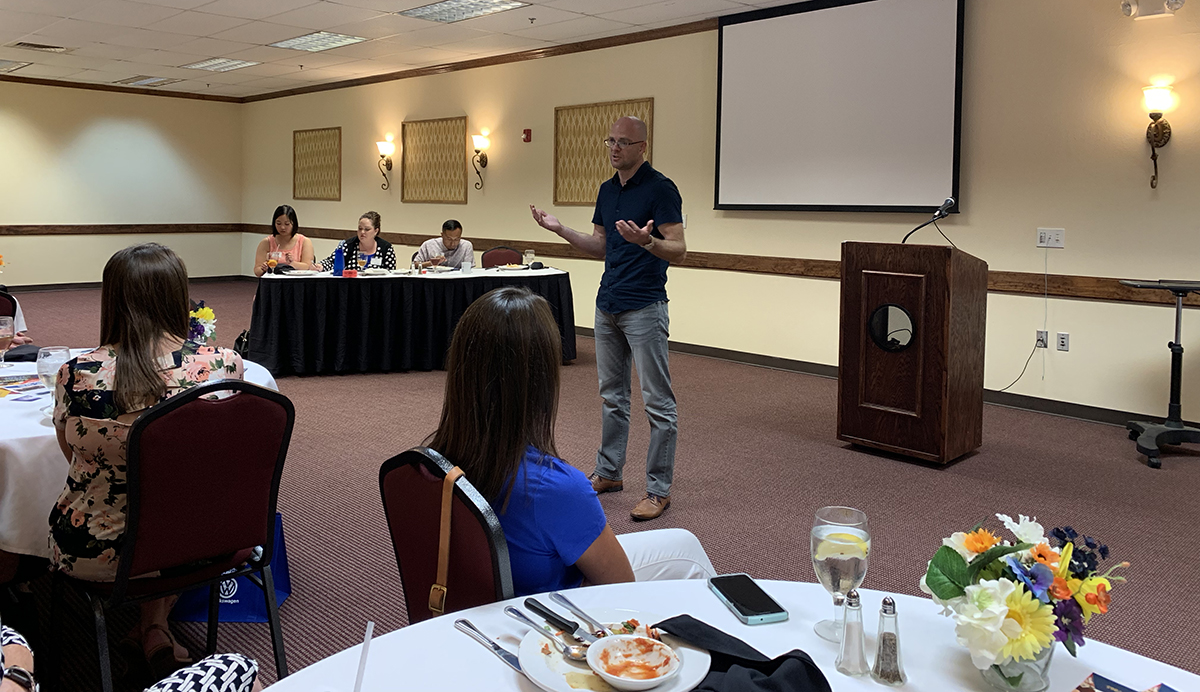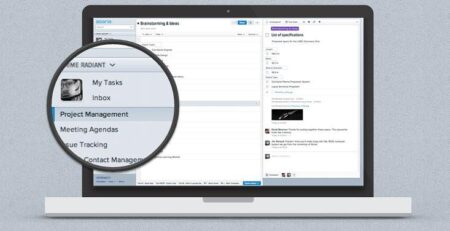How to Get People to Answer Emails, Make Decisions and Be Responsive
Expio Founder and CEO Andy Roller explains how to win the war for attention, follow up and responsiveness.
Excerpts from Andy Roller at American Advertising Federation-Amarillo speaking engagement:
I have five kids, and three of them have iPhones. In the event I need to get in touch with someone, I’ll text and call them, and nobody responds within a reasonable amount of time. I’m thinking, “I am paying over $300 a month to provide everybody a phone. Somebody answer the phone! What’s going on here!” It’s frustrating, right?
How could it be that they’re on their phones 24 hours a day, and the one time I need a clear answer from one of them, none of them are looking at their phones or want to respond?
Your personal relationships are the same thing. If you’re dating, if it’s your wife or your kid, your parents trying to make dinner reservations, whatever line of communication it might be, not getting a reply can be frustrating.
I think we’re all familiar with those scenarios. Let’s talk about some things that definitely do not work.
No ASAP
Expio Digital Marketing has three core values: No A-holes, No BS and no ASAP.
“No ASAP” doesn’t mean we’re not fast. Actually, we’re very fast. As a matter of fact, minutes before I got up here, the team handled a website crash. We’re very fast and responsive, but the no ASAP part of that (and I’ll explain how that gets into responsiveness) is understanding that ASAP is a type of poison to your company. If everything is always ASAP, nothing really is.
There are true emergencies, but a lot of times, clients will say, “I need this ASAP!” At Expio, we are all trained and have taught ourselves and each other that when that happens, we just ask the simple question: “Exactly by when do you need this?” They’ll usually respond something like, “Oh, next Thursday would be good.”
Alright… So let me get this straight, you just about threw our entire workflow off for the day (keep in mind in the service business our time is everything, that’s the asset, that’s the goal. We’re not a product company.) So you just about threw our entire workflow off for the day from everything else that we’re doing, because you wanted something next Thursday?
While we can’t necessarily correct the client on their use of language, we can ask questions that get to the essence of what’s needed. Sometimes it’s needed in the next five minutes, but that hardly ever happens. True ASAP is actually a very rare thing.
Even as the boss, I”m not allowed to do it. I think I’ve used the term ASAP one time in the last 8 ½ years, and Josh (Expio’s Chief Content Officer) called me on it immediately. So I’ve never done it again.
The reason I’m bringing that up is this: as a philosophy or as an approach, you need to get that straight so you’re a good example when it comes to responding. There’s a trust component when you’re dealing with people. When you’re really clear about what you need, you make it easy for the person to respond. It’s almost like giving multiple choice sometimes. “Do you want me to A, B, or C?” There are all kinds of creative responses, and we’ll talk about some of those tools.
Just Say No to Passive Aggressiveness
Another thing that doesn’t work is being passive-aggressive. You guys all probably have at least one of these people in your life. Maybe you are that person.
Don’t create drama or a sense of emergency all the time around something you need.
I got an email one time from a person who needed something, and they needed it right now (they didn’t really, but they thought they did), and they conveniently added into the email that “whenever someone doesn’t get back to me immediately, it causes me great anxiety.” I read that and I thought, “Well gosh, you know, I don’t want to cause anyone great anxiety… this is BS! What are you talking about?”
So there’s the passive-aggressive thing…“If you don’t get back to me I’m going to commit suicide.” No one’s ever said that to me, but they act like it’s this big emotional deal, when it’s not. What happens with a person like that is, if you play any level of that game, it decreases my desire and my response time. I’ll get to it when I get to it. You wanted it immediately, and you just got it pushed back for doing that; so that’s not going to work, and it just creates long-term problems.
Clarity is Everything in Business
Not being clear is a HUGE problem when it comes to getting people to get back to you. Sometimes people type out an email, and it’s not exactly clear what you need and when you need it. The receiver thinks, “Oh, I didn’t realize you needed an answer, I didn’t realize I needed to get back to you.”
When you start finding yourself putting a bunch of adverbs in the email: “I think maybe just very possibly, might want to…” Get rid of all of that and just ask the question, and get to what it is you need, especially in business relationships and business emails. Voicemails? The philosophy is the same. You can leave a five-minute-long voicemail, and the poor person listening is thinking, “I’m going to have to listen to this like three times to figure out exactly what it is this person needs.”
Building Trust
An Example From the Audience:
I have a company that calls us daily sometimes. The answer is no, it’s going to be no, it’s always been no.
We don’t have the budget, we’re not interested. I’m going to start saying it in French, German…
It’s a different sales person every time, so I guess they don’t note it in the file, or they have such
turnover that they’re not making notes on the clients. We just don’t answer the phone anymore, because
they won’t take no for an answer, and it’s just frustrating.
So let’s talk about that for a second. Is what they are doing building trust, or eroding trust with that brand?
Eroding it.
Obviously. As marketers, we all have to do some type of outreach. But is the approach building trust in the long run? So what they’re doing is spamming, they’re not paying attention to what you’ve said. They’re not giving you any space. I mean, daily? That’s a lot of follow up.
Here’s my favorite. You get an email from someone you’ve never met in your life. And it says, “About that thing we were talking about..” or “Following up on our conversation…” What conversation are you talking about? I don’t even know who you are!
Remove “Just” From Your Vocabulary
This one is simple, but important.
You don’t ever need to use the word ‘just’. “JUST checking on you…” “I’m JUST trying to see…” Get rid of all of that “just this” and “just that” and say what you need to say.
When it comes to people not getting back to you, I would say, always give the most generous explanation for a delay until proven otherwise. In my opinion, what people crave and want is clarity. Just tell me what you want, and if it’s worth my time I’ll be glad to sit down and give you the time and talk to you.
If it’s stupid, I need to be able to tell you that now. That would save us both a bunch of time, if you tell me what you want, then I can tell you if I think that’s a good idea or not. But if you’re trying to sell me some new brand of something, like soap, I’m good. I’ve got Dove Men’s Care that I buy in bulk at Costco. So, I’m not interested.
We think people are more fragile than they really are. So, we’re afraid to say what we need to say directly.
What Does Work
Let’s talk about things that do work. Let’s assume we’re all on the same page; we want to build trust with people so we don’t want to spam people. We don’t want to take the passive-aggressive, guilt-trip approach because that’s manipulating people. We’re all good people here. We’re trying to do a good job at our jobs. We’re trying to get an answer and get things done. I think that’s where most of us live most of the time. We are trying to take the next step; get a clear answer; move it forward.
- Active Status In Email: We use Google for pretty much everything. We’re Google mail-based, and we use Google docs and sheets. In the Google mailbox, you can see when a person is active. There is a little green thing that says “Active”, so you can see when people are active or not. If you see that green dot, they are obviously in their email.
- Mail Trackers: There are lots of mail trackers out there, allowing you to find out if the email got there, if they read it, if they forwarded it or not.
- Snooze: My favorite feature in Google is “Snooze.” This helps me follow people up. I can send an email, snooze it for next week and remind that person about the conversation.
- Follow-Up CC: If you don’t have google, you can do exactly the same thing with “Follow up CC”. I will send scheduled emails to myself and create myself a to-do list.
Snooze for Connection Opportunities
I use snooze all the time with business development. One of the things you can’t do in sales and business development is follow up every single day. People will have reasons that they need to wait, or get in touch with me next month or whatever. Hit snooze and time the emails out to remind yourself to follow up creatively. And never say “just checking in.” Please don’t ever send that in an email. Come up with something like, “I saw you in the news” or, “there’s some new information I saw” or, “I saw a friend of yours” etc.
There are thousands of things you can think of for why you need to get back in touch with somebody other than, “hey, just checking in.” They get those all day long. Snooze those emails to regularly check in with people until you get a clear answer about what they want to do. “Yes we will” or “No we won’t.”
I’ve had deals come through where I faithfully followed up until I got some kind of answer. They might say, “Call me in a year”. Okay, I will. So I snooze the email for a year, it pops up in a year, and I call them. I’ve landed plenty of deals that way.
A sales cycle is typically not that long, but it happens all the time. It’s the same way with getting other things done. But in sales, we’re the ones who want something, so it’s really on us to continue to follow up. The snooze feature on Google, and the scheduled send feature on Google are fantastic for that.
Find Tools For What You Need
There are a lot of tools out there to choose from. Some tools do way too much, and you don’t need a lot of what they do. Try to simplify your own workflow in a way that you are comfortable with> Then, only use the features and tools that work for you.
Here’s an example: We use “Pipedrive” as our CRM. Pipedrive has a lot of great features, and I could do all the emailing I’m talking about – the snoozing, the scheduling – inside the CRM, but for me, it’s a lot more effective to use only a couple of features of Pipedrive and handle all of the other responses inside Google. I keep track of deals and activities inside Pipedrive because that will generate reports for me and gives us meaningful data.
Piece tools together and use them in the simplest way possible that makes sense to you.
Make an Office Visit
If I can’t get a hold of someone whom I really need to talk to, and I’ve tried email, calls, texts, and I can’t get them, I show up. Here’s the thing, I only need a couple of minutes. I don’t need an hour. So if I really need to get a hold of somebody, I will just show up at their office. I’ll say, “Hey, you haven’t answered any calls or texts, so I thought I’d come by.”
Know Your Audience
If I send the Expio team a quick text, that form of communication has a particular cadence and language appropriate to the context. But, I don’t have that same relationship with new clients or people I don’t know very well. So, I’m going to use proper channels to approach them and excellent grammar and form. My message is going to look professional and nice, and it’s going to be tailored and geared toward that audience. As marketers, we all know that the No. 1 rule is “Know your audience.”
There are lots of differences these days in what’s considered appropriate or inappropriate, professional or unprofessional. You have to be cautious that you don’t offend people. You’ve got to know the different generations. It’s a little extra work. For a lot of younger people, a phone call can be considered strange. “Can I call you at 3 o’clock? We can set up an appointment…” We live in a much more egalitarian world. The reality is that human beings are still human beings. First impressions, while they don’t have to be perfect,do still matter.
Be a Good Listener
A good, professional person might be offering a good product or service, but if they left a bad impression, we have a way of pigeonholing that person. You have to work hard to avoid that, because the impression you create may be a negative one It’s going to put you into a box in that person’s mind.
And for us, the key is listening. Listening is a place of mutual understanding. Proactively, if we listen well to you, hopefully you reciprocate and listen well to us, and we can build a “you know that I know that you know that I know that this is what it is,” and we’re talking the same language, products, service development, etf. It matches our understanding. That takes place largely through listening.
Book Andy Roller
Andy is happy to speak on a variety of topics. Email us at info@expioconsulting to learn more.
Program Options
Option A: Personal Character and Leadership Development:
- Integrity | The Well Ordered Life
- Responsibility | The Nature of True Freedom
- Humility | The Path of Service and Security
- Empathetic Communication | The Heart of Leadership
- Coactive Vision | The Priority of Leadership
- Courageous Action | The Catalyst of Leadership
Option B: Culture and Team:
- Team and Culture Dynamics |The Ecology of Great Groups
- Structuring for Growth
- Social Leadership | From Job to Mission
Option C: Productivity and Learning:
- The Art of Follow-Through | Maximizing Your Personal Productivity
- Two Are Better Than One | Cultivating Successful Relationships
- The Critical Element of Personal Growth | The Process of Paying Attention
- View From the Top | The Use and Abuse of Authority and Power
- Making the Most of Your Moment | Developing the Spirit of Courage
- Sustaining Success | Skills for Life-long Learning
- Be Prepared | Leveraging Your Opportunities
- Winning the War for Attention, Follow up, and Responsiveness







Leave a Reply